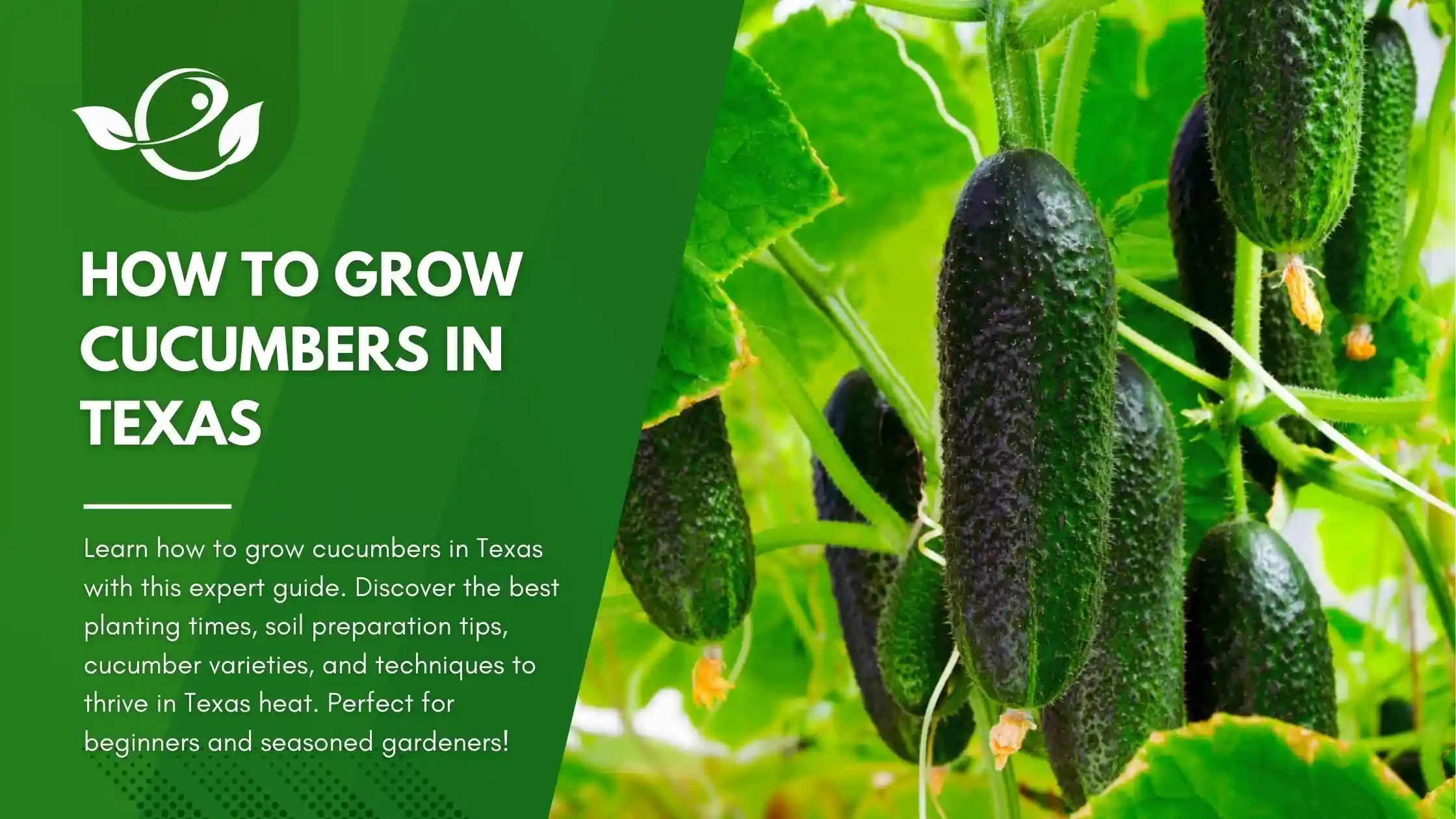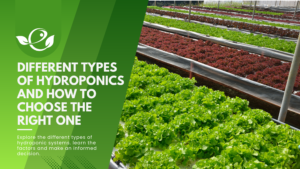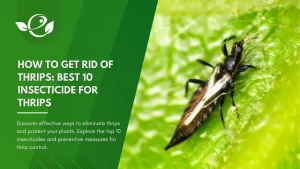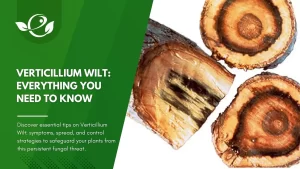Table of Contents
Cucumbers are one of the most rewarding vegetables to grow, especially in Texas, where the warm weather provides an ideal environment for their success. Whether you’re a seasoned gardener or just starting, understanding how to grow cucumbers in Texas ensures a healthy, productive harvest. In this guide, we’ll explore everything you need to know, including when to plant cucumbers in Texas, the best varieties for Texas conditions, and expert tips to help you navigate the unique challenges of the Texas climate.
Understanding Texas Growing Conditions for Cucumbers
Texas’s vast size means its climate varies significantly from one region to another. However, the overall warm weather makes Texas an excellent place to grow cucumbers, provided gardeners understand the specific challenges presented by the state’s conditions. The key factors include temperature, soil quality, and water availability.
Temperature Considerations
Cucumbers thrive in warm temperatures ranging from 70°F to 85°F, making spring and early summer the optimal growing seasons. However, temperatures above 95°F can stress cucumber plants, causing them to wilt or produce misshapen fruit. For gardeners in regions like South Texas, where summers can be especially hot, providing shade during the hottest part of the day can help mitigate heat stress.
In North Texas, the shorter growing season means timing your planting is critical to avoid late frosts or early summer heat. Meanwhile, in coastal Texas, high humidity levels can increase the risk of fungal diseases, so good air circulation and disease-resistant varieties are essential.
Soil Quality
Cucumbers need well-drained, nutrient-rich soil to grow successfully. Many parts of Texas have clay-heavy soil, which can retain too much water and suffocate plant roots. Amending the soil with organic compost or sand improves drainage and ensures the roots receive enough oxygen. Testing the soil’s pH is also important; cucumbers prefer a slightly acidic pH of 6.0 to 6.5. Adding lime or sulfur can help adjust pH levels as needed.
Water Availability
Texas’s unpredictable rainfall can make watering cucumbers challenging. While cucumbers need consistent moisture, overwatering can lead to root rot. A drip irrigation system is ideal for delivering water directly to the roots while conserving water—a crucial consideration in arid regions like West Texas. Mulching around the plants helps retain soil moisture and reduce evaporation.
Understanding these conditions and tailoring your approach to your specific region will set the foundation for a successful cucumber harvest in Texas.
When to Plant Cucumbers in Texas
Timing your planting correctly is one of the most important steps in growing cucumbers. Because cucumbers are highly sensitive to frost, planting them at the right time ensures a strong start and avoids cold damage.
Spring Planting
For most of Texas, the ideal time to plant cucumbers is after the last frost date, which typically falls between late March and early April (March 21st – 2nd week in April usually), depending on your location. In North Texas, where frosts can linger into early April, it’s wise to wait until soil temperatures reach at least 65°F. Starting seeds indoors 2-3 weeks before the last frost date is another option, allowing you to transplant seedlings once conditions are favorable.
Fall Planting
Cucumbers grow quickly, with most varieties maturing in 45-60 days, making a second planting possible in late summer. Plant seeds in early August to early September to take advantage of the cooler fall weather. This second planting is especially useful in Central and South Texas, where fall frosts arrive later. Be mindful of shortening daylight hours and consider planting fast-maturing varieties for best results.
Adjustments for Texas Heat
In regions with extremely high summer temperatures, like Central Texas, cucumbers planted too late in the spring can face heat stress. To combat this, gardeners can:
- Use shade cloths to reduce afternoon sun exposure.
- Plant cucumbers in raised beds, which warm up faster in spring and provide better drainage during heavy rains.
You can confidently determine when to plant cucumbers in Texas for optimal growth by carefully considering the climate and local frost dates.
Choosing the Best Cucumber Varieties for Texas
Selecting the right cucumber variety is critical to ensuring a successful harvest, especially in Texas, where heat and disease pressures can be significant. Some cucumber varieties are better suited to the state’s conditions than others.
Slicing Cucumbers
Slicing cucumbers are perfect for fresh eating and perform well in most parts of Texas. The following varieties are highly recommended:
- Straight Eight: A popular heirloom variety known for its long, straight fruit and crisp texture. It’s versatile and grows well in both spring and fall plantings.
- Marketmore 76: A reliable choice for Texas gardeners, this variety is resistant to diseases like powdery mildew and mosaic virus, which are common in humid regions.
- Spacemaster Cucumbers: A compact variety of cucumber plants that are ideal for home gardens. They have short vines that grow only 2 to 3 feet tall, making them suitable for smaller spaces. Despite their size, they produce a large quantity of full-size, tasty cucumbers.
- Japanese Cucumber: Japanese cucumbers thrive in hot weather, featuring a thin skin and a straight growth habit, making them ideal for slicing.
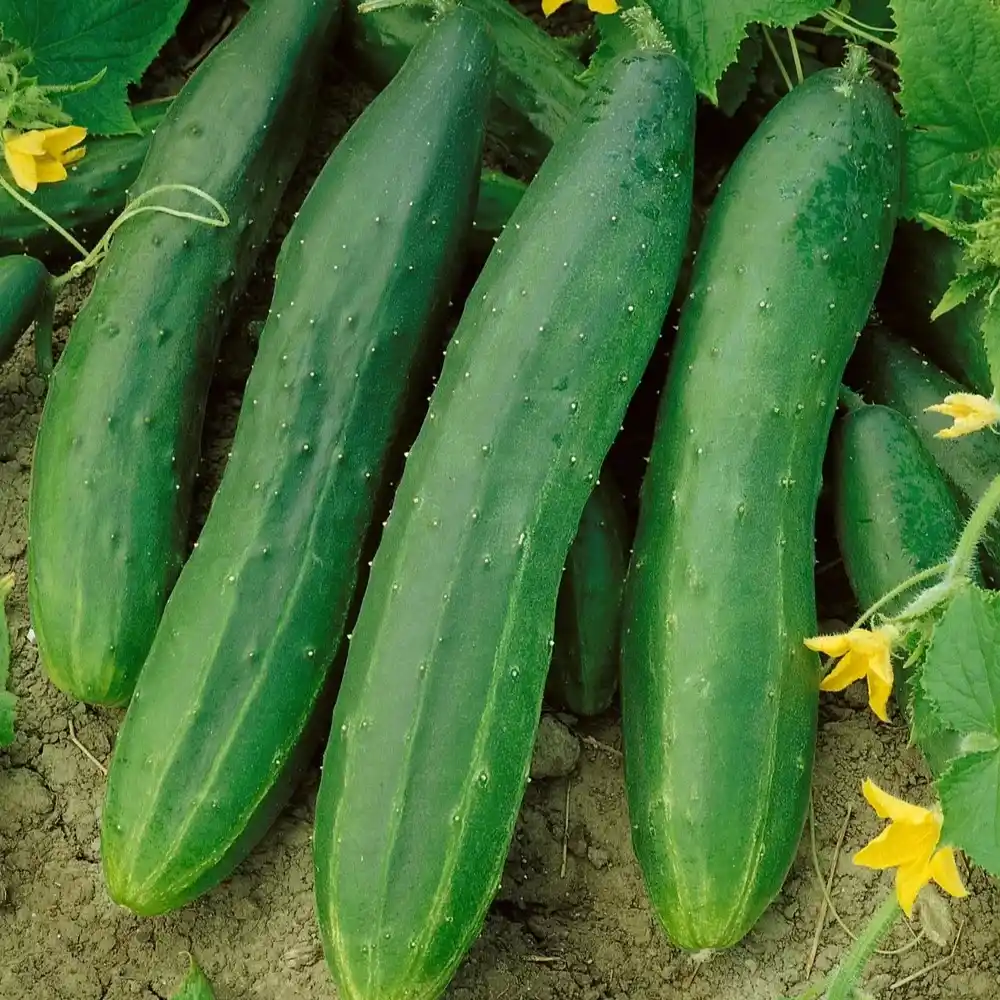
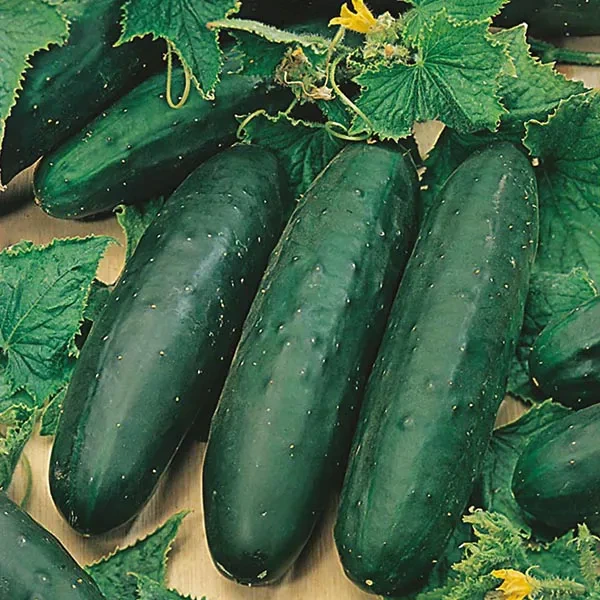
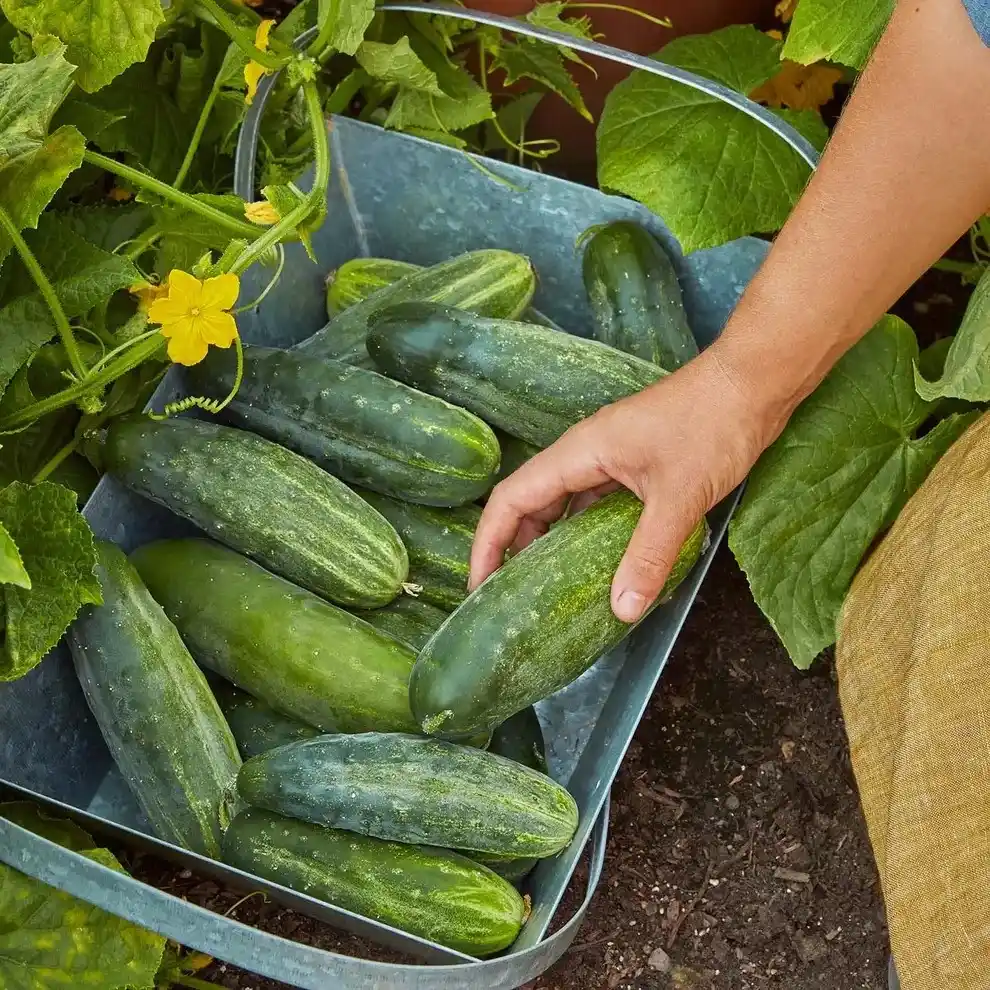
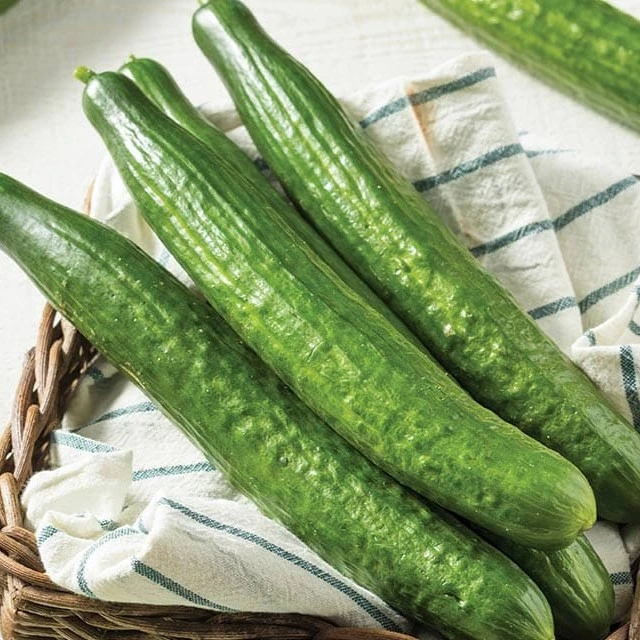
Pickling Cucumbers
Pickling cucumbers are smaller and more tender, making them ideal for pickling but equally delicious fresh. Consider these varieties:
- Hokus Gherkin Cucumbers: This variety is known for its crisp texture and tangy flavor. Harvest when each little fruit is between 2” and 4” long for the crunchiest French cornichons.
- Boston Pickling: Known for its high yield and consistent size, this variety is a favorite among Texas gardeners.
- National Pickling: Early-maturing and productive, it’s a great choice for areas with a shorter growing season.
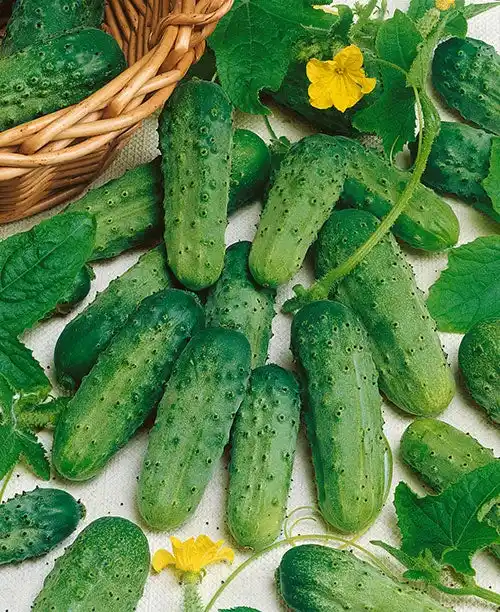
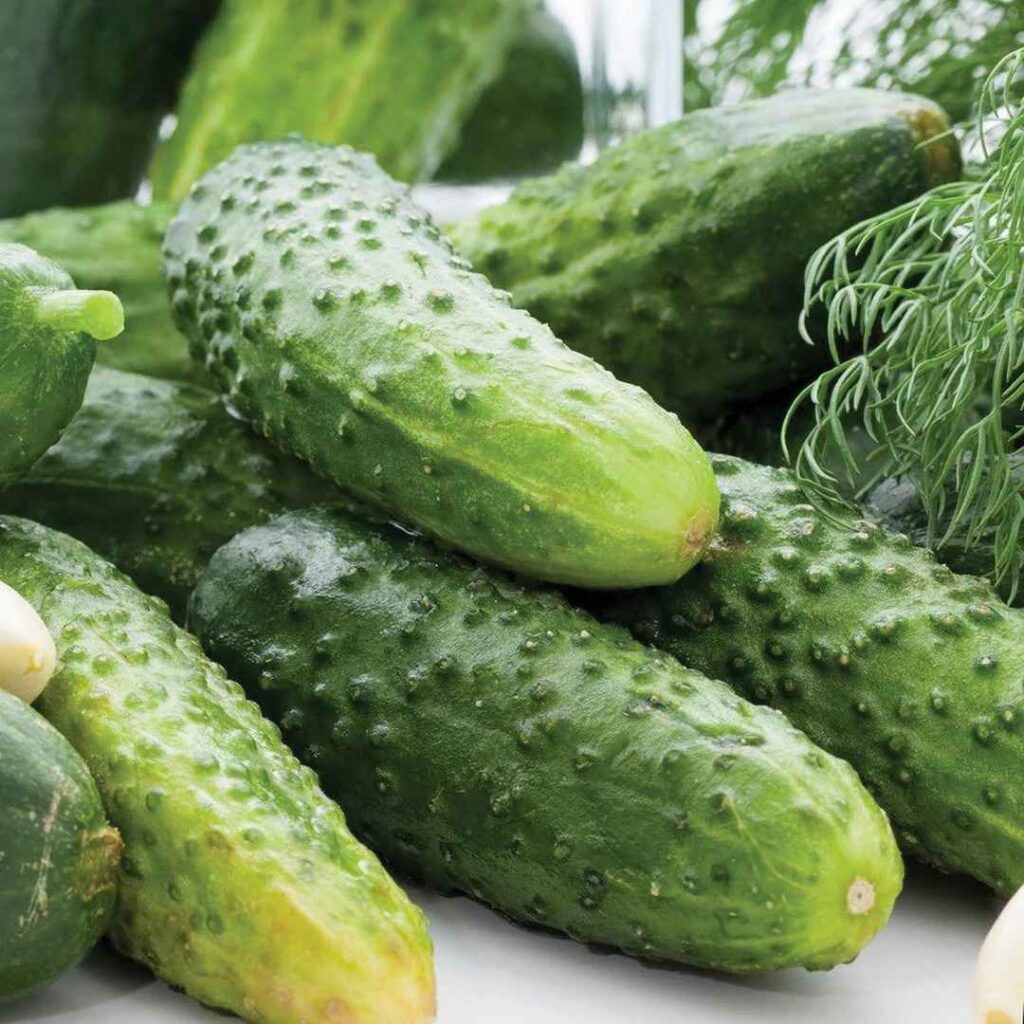
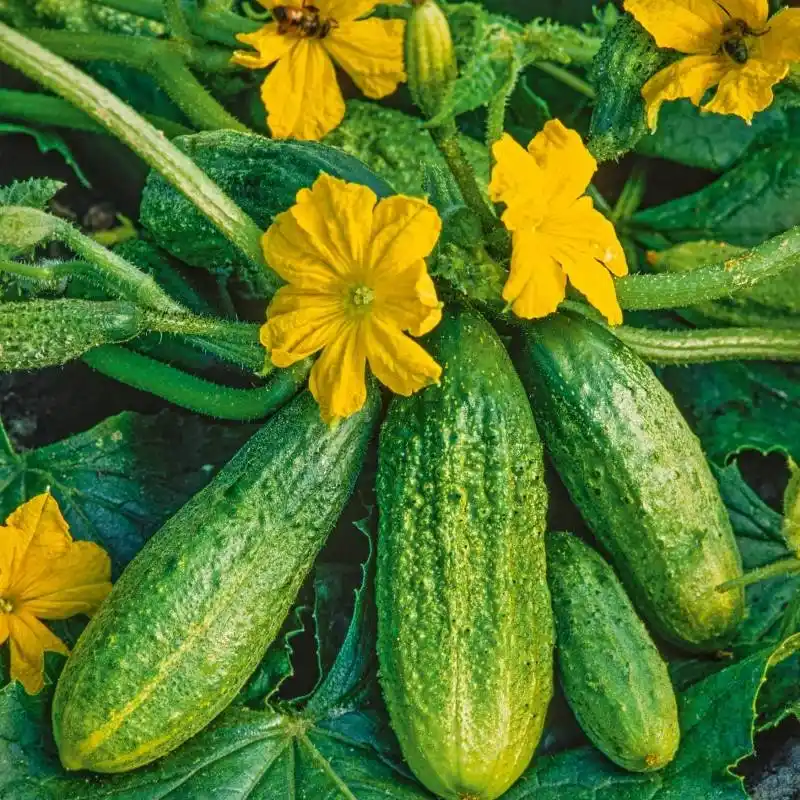
Hybrid and Specialty Varieties
For gardeners dealing with extreme heat or disease issues, hybrid varieties offer enhanced resilience. Some top choices include:
- Diva: This burpless variety is prized for its smooth skin and exceptional heat tolerance, making it ideal for Central and South Texas.
- Poinsett 76: A disease-resistant variety that thrives in hot and humid climates, making it perfect for East Texas.
Considerations for Choosing Varieties
- Disease Resistance: Opt for varieties resistant to common cucumber diseases such as downy mildew, powdery mildew, and bacterial wilt.
- Heat Tolerance: In areas like West and South Texas, heat-resistant varieties ensure consistent production even during hot spells.
- Growth Habit: Bush varieties are ideal for smaller gardens, while vining varieties can be trained on trellises to save space and improve airflow.
By selecting cucumber varieties tailored to your region’s specific challenges, you can enjoy a productive and rewarding growing season in Texas.
Preparing the Soil for Growing Cucumbers in Texas
Cucumbers require well-draining, nutrient-rich soil to thrive. Texas soils can vary widely, so proper preparation is key.
Soil Requirements:
- Drainage: Cucumbers prefer loose, sandy loam that drains well. Avoid heavy clay soils that hold water.
- pH Level: Aim for a soil pH between 6.0 – 6.5.
- Nutrient Content: Cucumbers are heavy feeders and benefit from nutrient-rich, organic soil.
Steps to Prepare Soil:
- Clear Debris: Remove rocks, large sticks, and trash from the planting area. Leave fine plant material such as dead grass and small weeds, as these will enrich the soil when turned under.
- Test Your Soil: Use a soil test kit to check pH and nutrient levels.
- Spade the Soil: Dig the soil to a depth of 8 to 12 inches, which is about the depth of a standard shovel or spading fork. Turn each shovel of soil completely over to cover all plant materials with soil.
- Create Raised Beds: Work the soil into beds that are 4 to 6 inches high and at least 36 inches apart. Raised beds are particularly important in heavy soils or poorly drained areas, as they provide the good drainage cucumbers need to thrive.
- Amend the Soil: Add compost, aged manure, or a balanced organic fertilizer to improve nutrient content. This enriches the soil and helps retain moisture.
- Mulch: Apply a layer of organic mulch to retain soil moisture, regulate soil temperature, and reduce weed growth.
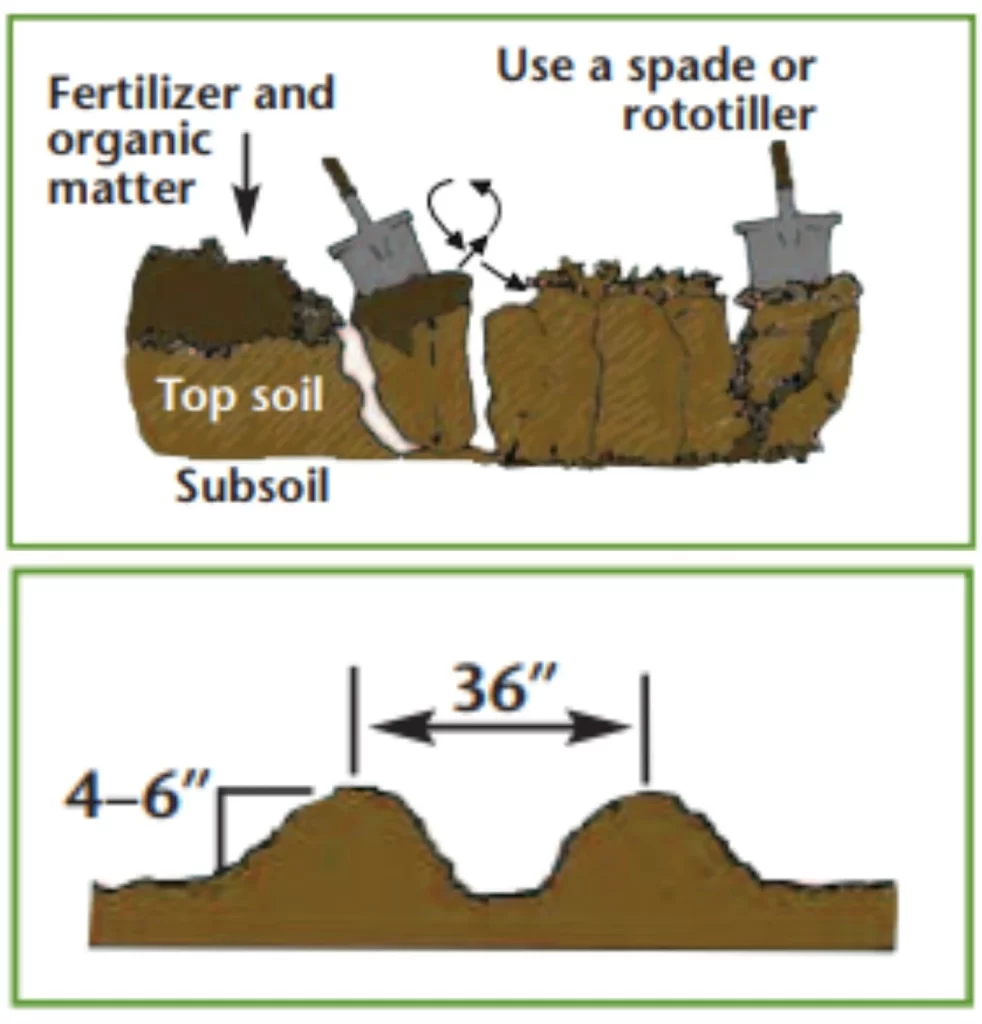
By properly preparing the soil, you create a strong foundation for healthy cucumber growth.
How To Plant Cucumbers in Texas
Planting cucumbers correctly is critical to their success. The method you use can significantly affect the plant’s growth and overall productivity. Here’s how to ensure proper planting:
Planting from Seeds
Cucumbers can be directly sown into the ground once the soil has warmed to at least 65°F. This method is easy and minimizes transplant shock. For best results:
- Sow seeds ½ inch deep in the soil.
- Drop three or four seeds in groups every 12 to14 inches down the row
- Water the seeds immediately after planting to settle the soil and provide moisture for germination.
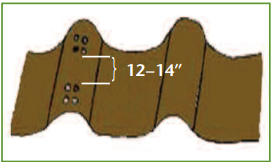
Transplanting Seedlings
If starting cucumbers indoors, transplant the seedlings outdoors when they have two to three true leaves and all risk of frost has passed. Follow these steps:
- Harden off the seedlings by exposing them to outdoor conditions for a few hours each day for a week before transplanting.
- Dig holes slightly larger than the seedling’s root ball and space them as you would seeds.
- Plant the seedlings at the same depth as they were in their containers, and water thoroughly after planting.
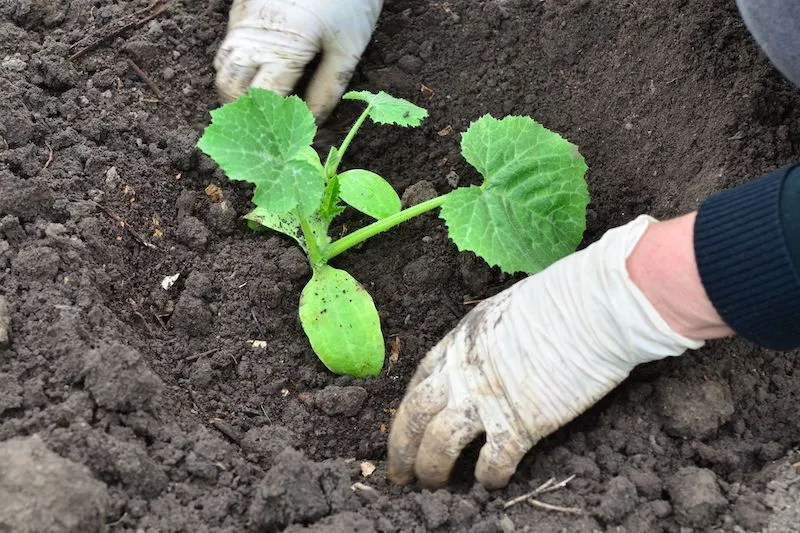
Trellising and Support
Cucumber plants, especially vining varieties, benefit from support. Trellises help:
- In a small garden, cucumbers can be trained along a wire attached to a wall.
- You can also use wire cage for Supporting the plant. If a wire cage is used, plant three or four seeds in hills 4 to 6 inches high along the cage.
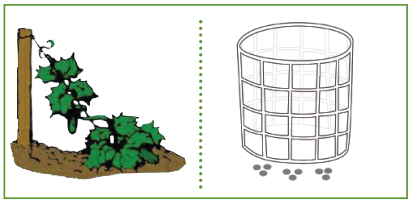

Companion Planting
Consider planting cucumbers alongside companion plants like marigolds, which deter pests, or legumes, which improve soil nitrogen levels. Avoid planting cucumbers near aromatic herbs like sage, as they can inhibit growth.
Watering and Fertilizing Cucumbers in Texas
Watering Needs:
- Cucumbers require 1-2 inches of water per week.
- Water deeply to encourage strong root development, especially during droughts.
- Avoid watering the leaves to prevent fungal diseases.
Fertilizing Schedule:
- Before Planting: Apply a balanced fertilizer (10-10-10) or organic compost.
- During Growth: Feed with a side dressing of compost or a nitrogen-rich fertilizer every 3-4 weeks.
- When the vines are about 10 to 12 inches long, apply about ½ cup of fertilizer for each 10 feet of row or 1 tablespoon per plant.
Managing Common Pests and Diseases
| Pests/Diseases | Identification | Control Measures |
|---|---|---|
| Cucumber Beetles | Yellowish-green beetles with black spots or stripes. | – Cultural: Crop rotation, remove debris. – Mechanical: Floating row covers. – Biological: Beneficial nematodes. – Chemical: Spinosad insecticide. |
| Aphids | Clusters of green, black, or yellow insects on leaf undersides. | – Cultural: Attract ladybugs. – Mechanical: Spray plants with water. – Chemical: Neem oil or insecticidal soap. |
| Spider Mites | Fine webbing and tiny moving dots on leaf undersides. | – Cultural: Maintain humidity. – Mechanical: Hose down plants. – Chemical: Use labeled miticides. |
| Squash Bugs | Brownish-black bugs on leaf undersides. | – Cultural: Remove debris. – Mechanical: Handpick bugs and eggs. – Chemical: Use appropriate insecticides for heavy infestations. |
| Powdery Mildew | White, powdery spots on leaves and stems. | – Cultural: Proper spacing, avoid overhead watering. – Chemical: Apply fungicides with sulfur or potassium bicarbonate. |
| Downy Mildew | Yellow, angular spots on leaves with gray mold underneath. | – Cultural: Plant resistant varieties, ensure drainage. – Chemical: Preventative fungicides for humid conditions. |
| Bacterial Wilt | Wilting leaves and sticky, milky sap from stems. | – Cultural: Remove infected plants. – Mechanical: Control cucumber beetles. – Chemical: Insecticides targeting cucumber beetles. |
| Cucumber Mosaic Virus (CMV) | Mottled, distorted leaves and fruits; stunted growth. | – Cultural: Remove weeds and infected plants. – Mechanical: Control aphids. – Chemical: Use insecticidal soaps for aphids. |
Harvesting Cucumbers in Texas
Harvesting cucumbers at the right time is crucial to ensure they have the best flavor, texture, and nutritional value. Cucumbers grow quickly, so keeping a close eye on their development is essential.
When to Harvest Cucumbers
- Slicing Cucumbers: Harvest slicing cucumbers when they are 6 to 8 inches long, firm, and uniformly green. Overripe cucumbers turn yellow, become tough, and may taste bitter.
- Pickling Cucumbers: These are ready for harvest when they are about 3 to 4 inches long, crisp, and tender.
- Frequent Harvesting: Regular harvesting encourages plants to produce more fruit. Mature cucumbers left on the vine signal the plant to slow down production.
- Signs of Readiness: Look for cucumbers with a smooth, bright, and glossy surface. Avoid harvesting cucumbers that feel soft or have wrinkles, as this indicates they are past their prime.
How to Harvest Cucumbers
- Use sharp scissors or pruners to cut cucumbers from the vine, leaving a short piece of the stem attached. This prevents damage to the vine, which could reduce future yields.
- Avoid pulling or twisting cucumbers off the vine, as this can stress the plant and harm its growth.
- Harvest in the early morning when cucumbers are cooler and retain more moisture, ensuring better taste and texture.
How to Store Cucumbers?
- Short-Term Storage: Store fresh cucumbers in the refrigerator for up to one week. Wrap them in a paper towel to absorb excess moisture and prevent rotting.
- Preservation Options: For long-term storage, cucumbers can be pickled or fermented. These methods retain their flavor and allow you to enjoy your harvest well beyond the growing season.
Tips for Success: Growing Cucumbers in Texas
Texas heat presents unique challenges for growing cucumbers, including extreme temperatures, high humidity, and water scarcity in some regions. However, with proper strategies, gardeners can overcome these hurdles and achieve a bountiful harvest.
- Shade Cloths: Use a shade cloth (30-50%) during peak summer afternoons to protect plants from excessive sunlight and reduce heat stress.
- Consistent Moisture: Cucumbers need 1-2 inches of water per week. Inconsistent watering can cause irregularly shaped fruit and reduce yield.
- Drip Irrigation: Use a drip irrigation system to deliver water directly to the roots, minimizing evaporation and keeping foliage dry to prevent diseases.
- Mulching: Apply a 2-3 inch layer of organic mulch (straw, wood chips, or grass clippings) to retain soil moisture, regulate temperature, and suppress weeds.
- Select hybrid cucumber varieties specifically bred for heat tolerance, such as Diva, Poinsett 76, or Straight Eight. These varieties thrive in Texas’s challenging summer conditions.
- Avoid excessive nitrogen, as it can lead to lush foliage but fewer fruits.
- Monitor plants regularly for signs of pests like aphids, spider mites, or cucumber beetles. Early detection allows for quick intervention.
- For gardeners in regions with severe heat, consider planting cucumbers in raised beds to improve drainage and prevent waterlogging after heavy rains.
FAQs About Growing Cucumbers in Texas
When should you plant cucumbers in Texas?
Plant cucumbers in early spring after the last frost or in late summer for a fall harvest which typically falls between late March and early April (March 21st – 2nd week in April usually).
What is the trick to growing cucumbers?
Provide consistent watering, nutrient-rich well-drained soil, and adequate support like trellises for healthy growth.
How long does it take for a cucumber plant to produce fruit?
Cucumbers typically produce fruit 35-55 days after planting, depending on the variety.
Do you need a trellis to grow cucumbers?
A trellis is not required but highly recommended as it improves airflow, prevents disease, and makes harvesting easier.
Should you cut yellow leaves off cucumber plants?
Yes, remove yellow leaves to improve air circulation, prevent disease, and redirect energy to healthy growth.
Do you use Epsom salt when planting cucumbers?
Yes, Epsom salt can be used if the soil lacks magnesium. Mix 1 tablespoon of Epsom salt in a gallon of water and apply as needed.
Should I water cucumbers every day?
Not necessarily. Cucumbers need 1-2 inches of water per week. Water deeply 2-3 times a week instead of shallow daily watering, depending on soil and weather.
